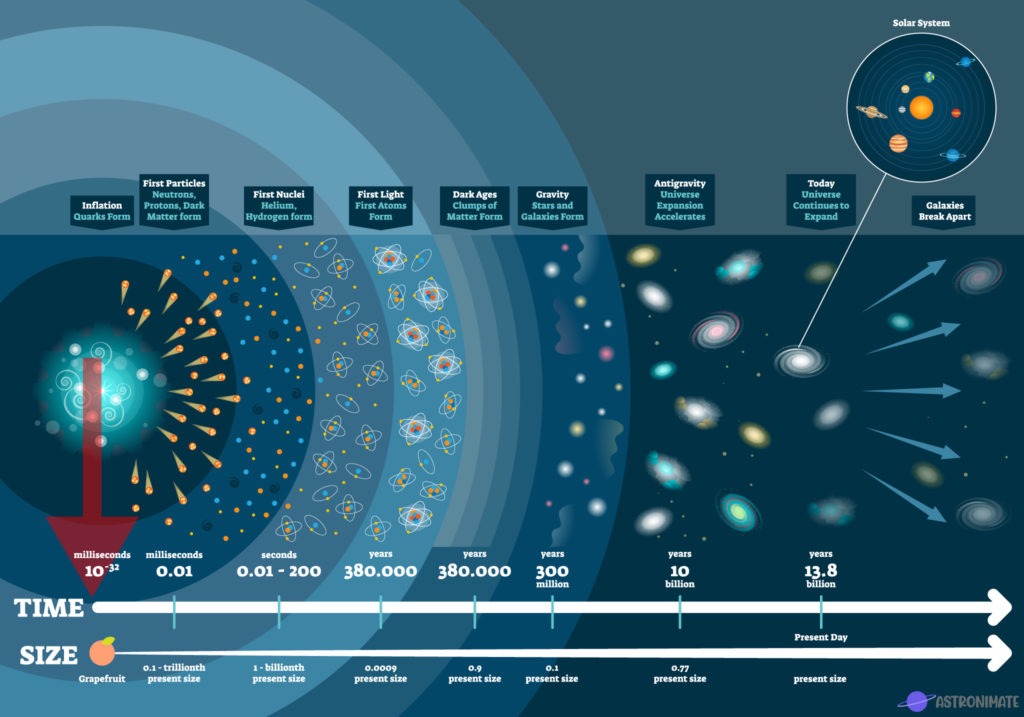This is your mission 03 of the epochs of the Universe.
The Electroweak Era forms the first particles that would give way to matter.
So if you want to travel back in time and experience the Electroweak Era, then this article is for you.
Let’s get started!
Mission 03 of the Epochs of the Universe – Electroweak Era
You are now embarking on the fourth epoch of the Universe.
As you continue to advance through the epochs, it is starting to make sense how a tiny singularity could expand rapidly into the present Universe.
In this epoch, we will see how the Universe rapidly expanded and what caused this rapid expansion.
Let’s delve into this epoch and learn more.
Mission Timeline – Electroweak Era
Mission Map – Electroweak Era
Mission Data – Electroweak Era
- Current Epoch: The Electroweak Era.
- Age of the Universe: Between 10^-36 seconds and 10^-12 seconds.
- Size of the Universe: It expanded by a factor of the order 10^26, almost the size of a grapefruit.
- Current Temperature: Between 10^28 Kelvins and 10^15 Kelvins.
Mission Briefing – Electroweak Era
After the Grand Unified Theory Era, you reach the Electroweak Era.
In this epoch, we see how cosmic inflation occurs and the formation of the first particles that would give way to matter.
There is a slight overlap between the Inflationary Epoch and the Electroweak Epoch because the Inflationary Epoch occurs inside the Electroweak Era.
What is the size of the Universe after inflation?
What were the first particles to be formed?
What led to the formation of the exotic particles?
Let’s move on to answer these questions and find out more about the Electroweak Era.
What Do You See?
Many developments occurred compared to the previous epoch, the Grand Unified Theory Era, visible to the naked eye.
In the previous epochs, the size of the Universe was very tiny. Still, in the Electroweak Era, cosmic inflation has occurred, and the size of the Universe increased rapidly.
It expanded by a factor of the order 10^26, resulting in a universe that grew from the size of a single proton to around 10 cm (4 inches) across, almost the size of a grapefruit.
Referencing the mission data, you can see that the Universe becomes older as it grows.
The Electroweak Era happens between 10^-36 seconds and 10^-12 seconds.
Within this timeline, the Inflationary Epoch also occurs. The Inflationary Epoch takes place between 10^-36 seconds and 10^-32 seconds.
Some astronomers and cosmologists place the Electroweak Era at the start of the cosmic inflation, around 10^-36 seconds after the Big Bang, while others place it 10^-32 seconds after the Big Bang.
We see many exotic particles forming during this epoch, such as the W and Z bosons and the Higgs bosons.
These particles were formed as a result of high-energy particle interactions, at the end of this epoch, when the Universe was 10^-12 seconds, the W and Z bosons decay.
Atoms and molecules are not formed in this epoch. Even after the Universe’s rapid expansion, the Universe’s temperature is still too high to allow the stable formation of many particles we see in today’s Universe.
So, there are no atoms and molecules to form matter, and therefore galaxies and stars have not formed yet.
Still, the Universe is in total darkness in this epoch. Light has not formed yet because of the reason stated above. Particles and molecules cannot bind because of high temperatures.
At least you now get to see some change in this epoch.
What Do You Feel?
Now let’s see what you feel about the rapid expansion of the Universe.
The Electroweak Era begins when the strong force separates from the electroweak force because the Universe’s temperature was low enough (10^28 K).
This separation resulted in a scalar field called the inflation field that generated enormous potential energy to trigger the Universe’s rapid expansion.
The rapid expansion of space meant that the elementary particles from the Grand Unified Theory Era were sparsely distributed across the Universe.
Inflation ended when the inflation field decayed into other particles known as reheating. After the Inflation Period ended, the Universe continued to expand, but at a much slower rate.
As the temperature continued to fall, the electroweak symmetry breaking happened, which resulted in some side effects.
After the electroweak symmetry breaking, the fundamental forces have taken their current form. The elementary particles have their projected masses.
The temperature continues to fall as the Universe expands. During this epoch, the temperature is between 10^28 Kelvins and 10^15 Kelvins.
In the Inflationary Period, it falls from 10^28 Kelvins to 10^22 Kelvins. Then after that, it drops gradually until 10^15 Kelvins. Also, the Universe is now less dense after inflation because the volume has increased.
What is Happening? Scientific Explanation
Now we get to learn about the scientific background for this epoch.
Appearance
There’s a change in the appearance of the Universe during the Electroweak Era.
The rapid change in size is so apparent; you can’t miss it. During the Inflationary Period, the volume of the Universe increased by a factor of 10^26, resulting in an enormous universe.
A universe that you can easily observe, unlike in the previous epochs where it was very small.
This epoch began when the Universe’s temperature had fallen enough to separate the strong force from the electroweak force. The separation triggered the inflation of the Universe.
Do you wonder how?
Well, during this phase transition, the inflation field is created, and it settles on its lowest energy state. As a result, an enormous force was generated that led to the rapid expansion of the Universe.
Ordinary particles from the Grand Unified Theory Era are now sparsely distributed across the Universe, resulting in few interactions.
Particle interactions on this epoch are energetic enough to produce many exotic particles, such as W and Z bosons and the Higgs boson. At the end of this epoch, the W and Z bosons decay.
With the expansion of the Universe, all the parameters have changed. The temperature has dropped to 10^15 Kelvins. The density and pressure have also reduced.
Light does not exist, so there are no galaxies or stars. This is because high temperatures prevent particles from binding to form matter.
Time
The Electroweak Era happens after the Grand Unified Theory Era. The timeline of this epoch is between 10^-36 seconds and 10^-12 seconds after the Big Bang. To the human mind, this is a brief period.
The Electroweak Era includes the Inflationary Epoch, which happens between 10^-36 seconds and 10^-32 seconds.
The rapid expansion of the Universe happens for only 4 seconds during this period.
Some models describe the Electroweak Era as starting during the Inflationary Period around 10^-36 seconds after the Big Bang, while others describe it as starting after the Inflationary Period, 10^-32 seconds after the Big Bang.
The time difference between this era and the previous era, Grand Unified Theory Era, is 10^-24 seconds.
Mission Summary – Electroweak Era
The Electroweak Era is about the rapid expansion of the Universe during the Inflationary Period and the formation of W and Z bosons and the Higgs boson.
This epoch begins when the strong force and the electroweak forces separate because the temperature was low enough. This separation then resulted in the release of a massive repulsive force that is believed to have triggered the rapid expansion of the Universe.
The expansion occurred between 10^-36 seconds and 10^-32 seconds after the Big Bang. Elementary particles were thinly distributed across the Universe.
Even after the end of the inflation period, the Universe continued to expand, but at a much slower rate as the temperature continued to drop. The temperature was between 10^28 Kelvins and 10^15 Kelvins.
The size of the Universe has increased by a factor of 10^26 that is almost the size of a grapefruit due to the rapid expansion.
Light, galaxies, and stars do not exist in this epoch because the temperature is still too high for the particles to bind.
At the end of this epoch, the W and Z bosons decay. The electroweak symmetry breaking happens, whereby the electroweak interaction separates into electromagnetic and weak forces.
Addition Mission Resources – Electroweak Era
Here are some of the frequently asked questions about Mission 03, the Electroweak Era.
Is the Inflationary Epoch Part of the Electroweak Era?
The answer to this question is speculative.
Some models describe that the Electroweak Era begins after the Inflationary Epoch ended, around 10^-32 seconds after the Big Bang.
While in other models, it is described as including the Inflationary Epoch, which means that it began at the same time as the Inflationary Epoch, 10^-36 seconds.
What Are the Effects of the Electroweak Symmetry Breaking?
One of the effects of the electroweak symmetry breaking is that all the elementary particles interacting with the Higgs field became massive. Before, the particles were massless at higher energy levels.
The second effect is that the weak force, electromagnetic force, and their respective bosons and photon begin to behave differently.
Before the electroweak symmetry breaking, the bosons were massless. They had long-distance interactions, but the bosons became massive and started to interact over short distances after the transition.
Can the Elementary Particles Form Matter?
The elementary particles can form matter because after the electroweak symmetry breaking happened, the W and Z bosons became massive particles.
The only reason why matter could not form during this epoch is that the temperature was still too high to allow for the binding of particles.
Is the Universe Still Expanding?
Yes, the Universe is still expanding today. After inflation ended, the Universe continued to expand, but at a much slower rate.
Around 4 billion years ago, the expansion rate began to increase gradually, which is believed to be due to dark energy predominant in the Universe’s behavior.


